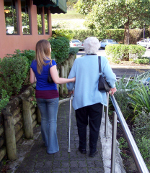Keeping Seniors Safe on the Stairs
Published by Stephen on October 2, 2009 Under fall prevention Arthritis is a very serious disease that usually affects the joints, causing swelling, inflammation, and general discomfort. Arthritis can affect people of any age, including children, and there are more than 100 known kinds of arthritis. However, two types of arthritis, osteoarthritis and rheumatoid arthritis, represent the majority of all cases and predominantly affect those over the age of 65.
Arthritis is a very serious disease that usually affects the joints, causing swelling, inflammation, and general discomfort. Arthritis can affect people of any age, including children, and there are more than 100 known kinds of arthritis. However, two types of arthritis, osteoarthritis and rheumatoid arthritis, represent the majority of all cases and predominantly affect those over the age of 65.
One of the factors that is characteristic of both of these types of arthritis is reduced mobility. Often, it is the hands, feet, and other smaller joints that are affected by these types of arthritis, but hip arthritis and knee arthritis are also very common. When this happens, things like using the stairs can be very difficult and much more dangerous, with staircase falls being the leading cause of accidental injury requiring a hospital say among seniors.
Keeping the Stairs Safe and Well Maintained
To help make the stairs safer for seniors and others with arthritis, there are several things that can be done. One of the most important things is to ensure the staircase is in good condition and provides secure easy to use handrails. In fact, a recent study found that by having two handrails, one on either side of the staircase, the risk of a fall could be dramatically reduced.
It is also very important that the stairs are well lit, with a light switch at both ends of the staircase. This ensures that the senior can see the stairs, without ever having to climb the stairs in the dark.
Keeping the Senior Safe
While keeping the staircase in good repair is incredibly important, it is also essential to realistically evaluate the abilities of the senior. Even with non-skid colored tape on the stairs and two handrails, if the senior is simply unable to safely use the stairs, than these precautions will not go very far.
For this reason, it is important to objectively consider their abilities in regards to safely using the staircase. There are many other factors, aside from arthritis, which can make using the stairs more difficult. For instance, poor vision can greatly increase the risk of a fall, as the senior is more likely to miss a step. Alzheimer’s Disease and other types of dementia can also reduce balance, making the senior more unsteady on their feet. In most cases, it is not simply a single disorder that results in the inability to safely use the stairs, but rather a combination of these types of conditions.
It may be necessary to restrict staircase access, consider moving to an area where stairs is not an issue, such as a nursing home or assisted living facility, or installing some sort of staircase safety aid. Since elevators are quite expensive, a more cost friendly approach is to install a stair lift, which is an electronic device that literally carries the senior up the staircase, so they do not have to risk walking up it on their own.
No Comments |
Add a Comment